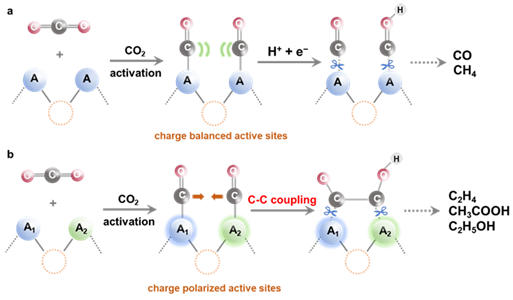《Acc. Chem. Res.》: Fundamentals and Challenges of Engineering Charge Polarized Active Sites for CO2 Photoreduction toward C2 Products
Yang Wu,+ Qinyuan Hu,+ Qingxia Chen,* Xingchen Jiao,* and Yi Xie*
Excessive emissions of carbon dioxide (CO2) are contributing to global warming and climate deterioration, and the conversion of CO2 into carbon-containing fuels using solar energy can simultaneously mitigate both climate deterioration and energy shortages. In the past decade, although CO2 photoreduction research has made great achievements, it still faces great challenges in terms of product selectivity and activity. On current catalysts, CO2 photoreduction usually yields C1 products, and due to the kinetic challenges of C-C coupling of C1 intermediates,it is difficult to obtain C2 products with high economic value and energy density. Therefore, in order to realize CO2 photoreduction to C2 fuel, it is important to design highly active photocatalysts to accelerate C-C coupling.
Currently, the mechanism of CO2 photoreduction for the preparation of C2 fuels is usually uncertain, which may be due to the difficulty in determining the actual catalytic site of the C-C coupling step and the difficulty in monitoring the low concentration of active intermediates in the multi-electron transfer process. In view of this, this paper focuses on various strategies for the photocatalytic reduction of CO2 to C2 fuels including vacancy engineering, doping engineering, loading engineering, and heterojunction engineering for designing charge-polarized active sites to facilitate C-C coupling. Meanwhile, various in situ characterization techniques such as in situ X-ray photoelectron spectroscopy, in situ Raman spectroscopy and in situ Fourier transform infrared (FTIR) spectroscopy are outlined in this paper for identifying the charge-polarized active sites and monitoring the reaction intermediates, which can help to gain insights into the internal catalytic mechanism for the generation of C2 products by CO2 photoreduction.
The first authors of this article are Dr. Yang Wu from the University of Science and Technology of China, and Qinyuan Hu, master student, Jiangnan University. The corresponding authors are Prof. Yi Xie from the University of Science and Technology of China, Prof. Xingchen Jiao from Jiangnan University. Associate Prof. Qingxia, Chen from Jiangnan University.
link:https://doi.org/10.1039/D2CS00688J

Figure 1. Possible CO2 photoreduction processes at (a) charge-balance active sites and (b) charge-polarization active sites

Figure 2. CO2 photoreduction process of C2 products on charge polarized photocatalyst
